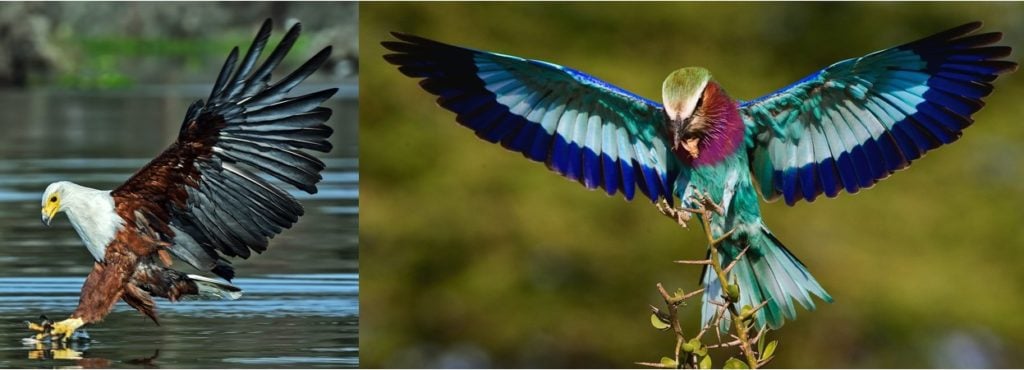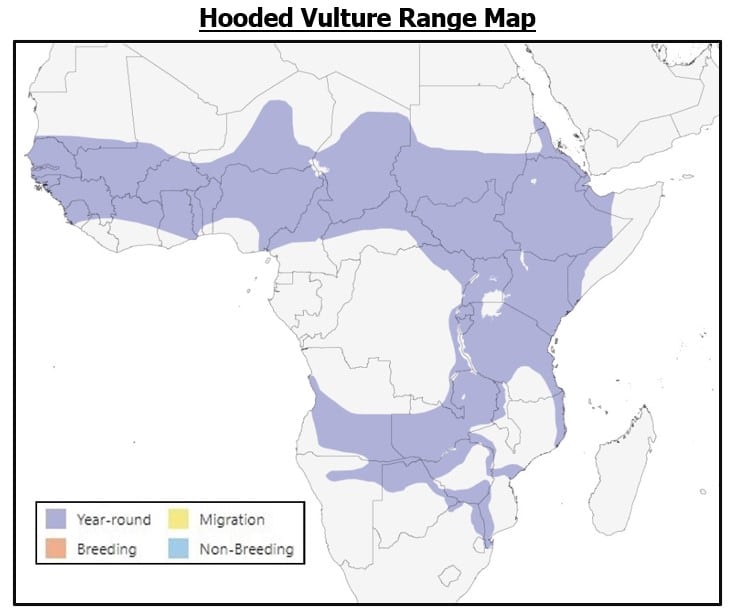10 COMMON Birds Found in Sierra Leone! (2025)
Are you trying to identify a bird found in Sierra Leone?

Some of the wildest and most colorful birds you could imagine are found here. From gigantic, flightless birds to colorful showstoppers, there’s something to catch everyone’s attention!
Due to the sheer number of species, there was no way to include every bird in Sierra Leone in this article. So instead, I tried to focus on the birds that are most regularly seen and observed.
10 COMMON types of birds in Sierra Leone!
#1. Great Blue Turaco
- Corythaeola cristata

Identifying Characteristics:
- Adults are 70–76 cm (28–30 in) tall.
- Their bodies, wings, and tail feathers are gray-blue. They have a mohawk-like crest that is deeper blue, and their chests are moss green, with deep red plumage on the legs.
- Their bulky, curved beaks are bright yellow with a red tip.
The Great Blue Turaco is sometimes called the “Blue Plantain-Eater” due to its affinity for the starchy fruit. Look for this bird in Sierra Leone where trees grow close together, like woodlands and plantations.
This species often acts more like a flying squirrel than a bird! Since the Great Blue Turaco is not a great flier, it climbs trees and soars from high points to lower branches in nearby trees, only to climb up once again and soar to the next.
They can move about this way thanks to their unusual feet that clasp branches very well and allow them to navigate within trees like a monkey. They only come down to the ground to drink or take a dunk in a nearby body of water.
These highly social birds usually live in groups of up to 20, cohabitating without territorial disputes. During breeding, the males compete for females by showing off their crests.
#2. Hamerkop
- Scopus umbretta

Identifying Characteristics:
- Adults stand about 56 cm (22 in) tall.
- Brown all over, with a dark brown to black bill and legs.
- This waterbird has an unusual crest, making its head appear elongated toward the back.
You might have seen pictures of the Hamerkop on its favorite perch – the back of a hippopotamus! This water bird likes to hunt from these living platforms, and the hippos don’t seem to mind.
An easy way to identify this bird in Sierra Leone is to look for its incredible nest. They build a huge nest (up to two meters tall) in a tree fork, with only a tiny side entrance. The same nest can be used for up to four years unless it is disturbed in some way, which happens more often than you might think.
They’re also rather noisy, cackling and yapping while they hunt and socialize.

#3. Helmeted Guinea Fowl
- Numida meleagris

Identifying Characteristics:
- Adults grow up to 53-58 cm (21-23 in).
- Their coloring is black with white spots. The legs are black, and the featherless head is bright blue with red on the face.
- This species has a large, round body and a very small head and neck.
These chicken-like birds in Sierra Leone are capable of flight but only do so when in danger.
Instead, they walk up to 10 kilometers (6 miles) daily in their quest for food. They’ll eat anything from small mammals and lizards to worms, insects, frogs, small snakes, snails, seeds, fruit, and spiders.
Outside breeding season, they form flocks of up to 24 birds and roost communally so they can alert each other to predators. They have an explosive take-off and only flap for short distances, gliding for longer flights. They prefer to flee from predators on land and can run 35 kph (22 mph) on land.
Helmeted Guineafowl have various calls, and some are more pleasant than others. For example, their whistling tune is much nicer on the ears than the raucous and irritating one found here.

#4. Hooded Vulture
- Necrosyrtes monachus

Identifying Characteristics:
- Adults are 62–72 cm (24–28 in) long with a wingspan of 155–180 cm (61–71 in).
- Their plumage is a uniform brown, with a featherless pinkish-white face and a grey-brown “hood” of short feathers.
- This large vulture has an upright posture, large body, and small head, which are typical of its kind.
The Hooded Vulture is more mild-mannered than most other scavengers in Sierra Leone.
As a result, it’s developed skills to make sure they can eat before more aggressive vultures chase it off from a carcass. It often arrives first, takes a small meal, and moves on, eating more frequently and in smaller portions.
Another way this species has adapted is to start visiting slaughterhouses and garbage dumps. Here, they take advantage of easy meals. The clever part is that the bigger, more aggressive vultures are not comfortable around humans, so Hooded Vultures avoid conflict.
Despite finding ways to adapt and survive, Hooded Vultures are still considered critically endangered. Often, when poachers kill big game, they remove the valuable parts and then poison the carcass with pesticides. These toxins kill any vultures that come to feed, so rangers won’t see vultures circling the carcasses, and the criminals have more time to get away.
#5. Little Bee-Eater
- Merops pusillus

Identifying Characteristics:
- Adults are 15–17 cm (6-7 in.) long.
- They have a green back, a bright yellow throat, and a black collar. Their bellies are a deeper brownish-yellow.
- This species is slender and upright, with a pointed black beak.
Little Bee-eaters are the smallest species of African bee-eater. These birds are quite tame and friendly. They make practically no sound except for a quietly trilled “s-s-e-e-e-p.”
As their name implies, these little birds subsist on hornets, wasps, and bees. But, they’ve found an efficient way to avoid being stung by their favorite foods. Before they eat them, they smash their prey’s stinger into a hard surface several times to extract it.
Look for groups of Little Bee-eaters lined up, roosting communally on a branch. These tight-knit communities spend time together year-round. For example, a non-breeding pair will help feed chicks and even sit on the eggs to help out. Some nesters can have as many as five helpers raising the nestlings.
#6. Pied Crow
- Corvus albus

Identifying Characteristics:
- Adults are 46-52 cm (18-20 in) long.
- Their coloring is completely black, except for the stark white “vest” between their wings and across their chest.
If you’ve ever wondered about the difference between a crow and a raven, studying the Pied Crow is a good way to learn! This bird in Sierra Leone is considered a “link” between the two related families. It has the larger bill and long legs of a raven, as well as wider wings and a longer tail. However, its beak is small and straight like a crow’s, and it also has the typical “caw” call.
Pied Crows are often found near humans, but they don’t interact with people very much. They seem to like villages and towns, probably because of the abundance of food due to human refuse.
They are social and may congregate near an abundance of food but are generally found in pairs or small groups. Pied Crows eat reptiles and mammals, nestlings and eggs, insects and invertebrates, peanuts, grains, carrion, and human trash. If there is a slaughterhouse in the vicinity, you’ll almost certainly find them there, too.
#7. Pied Kingfisher
- Ceryle rudis

Identifying Characteristics:
- Adults grow to 25 cm (10 in) long.
- Their coloring is white, with small black spots on the face, head, wings, tail, and shoulders.
- This species has an extremely long and sharp beak.
Pied Kingfishers are the largest hovering bird in Sierra Leone.
They often hover over a body of water, hunting until they spot a likely victim. Then, they drop vertically into the water, grab their prey, and leap out again. In addition, they often eat small prey in flight, allowing them to hunt small insects continuously without the need to return to shore.

Compared with other kingfishers, this species is gregarious and friendly. They often roost together in large groups at night. Pied Kingfishers are nearly always found close to large bodies of water.
#8. Pin-Tailed Whydah
- Vidua macroura

Identifying Characteristics:
- Adults are 12–13 cm (4-5 in) long, but males have exceptionally long tails – up to 20 cm (8 in)!
- Males are black on the back, head, and wings, with a white belly and throat.
- Females are light brown with black streaks.
- Both sexes have a short, conical, red-orange beak.
Look for Pin-tailed Whydahs in grassland habitats. It’s a common bird in Sierra Leone south of the Sahara.
This species is considered a brood parasite, meaning the female lays her eggs in the nest of other species. Then, once the eggs hatch, the mother takes care of the Pin-tailed Whydah hatchlings along with her own.
Unlike some other brood parasites, the Pin-Tailed Whydah doesn’t destroy the host bird’s eggs, which means other species can still thrive alongside it.
#9. Village Weaver
- Ploceus cucullatus

Identifying Characteristics:
- Adults are 15–17 cm (6-7 in) long.
- Males have a black face with a bright red eye, a bright yellow chest, a brown cowl down the back of the head, and splotchy black and yellow wings.
- Females are largely yellow (including the head), with pale olive stripes on the upper parts and buff-yellow chest and underparts.
The Village Weaver has some of the most interesting nesting habits of any bird in Sierra Leone.
For one, the nests themselves look like Christmas ornaments! They’re woven balls of grass and feathers that hang from the branches of trees. Additionally, male Village Weavers build the nests alone and defend them to attract a mate. Think of this as showing off your big, new house to your date!
Once a female chooses a nest (and a mate), she fills it with bedding and lays her eggs. Then, the male finds another mate and begins the process again! Despite having up to five broods at a time, the male Village Weaver contributes to the feeding and care of all his hatchlings.
These communal birds can be quite noisy, as they spend most of their time in their nests calling to one another.

#10. White-Throated Bee Eater
- Merops albicollis

Identifying Characteristics:
- Adults are 19–21 cm (7.5-8.5 in) long, with males gaining an additional 12 cm (5 in) from their tail streamers.
- Look for this species’ white throat and white eyebrow on either side of its black eye stripe to differentiate it from other Bee Eaters.
- Their coloring is bright green to white on the belly with a pale blue rump, a black collar underlined in turquoise, and bright yellow-orange on the back of the head.
White-throated Bee Eaters congregate in large groups, which protects them from predators. They also raise their young communally, sharing the duties of protecting nests and bringing food to nestlings.
Like others of their family, White-throated Bee Eaters eat hornets, wasps, and bees, catching them in mid-flight by leaping from a low perch. Before they eat them, however, they remove their prey’s stinger by jamming it into a hard surface several times to extract it. That’s a straightforward way to make sure your meal is safe to eat!
This species has a dry, high-pitched, rattling call.

Do you need help identifying birds in Africa?
These books will provide you with much more information!
Which of these birds in Sierra Leone have you seen before?
Leave a comment below!











